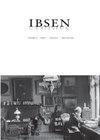Preface
IF 0.6
0 THEATER
引用次数: 0
Abstract
With this issue of Ibsen Studies, we get back to basics, as it were, publishing two articles that each in their own way reconsider what we think we already know about Ibsen’s reception and about A Doll’s House respectively. In “Networks, Asymmetries and Appropriations: Toward a Typology,” Narve Fulsås and Tore Rem consolidate the major patterns in Ibsen’s European reception history. They identify four differing strategies for how Ibsen gained access to theatre and book markets outside of Scandinavia. Fulsås and Rem first give an account of the playwright’s own early attempts to gain access to the German market—what they call “self-initiated mediation”—, noting how quickly he lost control over the fate of his own work. They go on to explain the pattern of “imperial appropriation” in which France and Britain in particular appropriated Ibsen’s works “In ways which ultimately served to reaffirm the centrality of their own, hegemonic literature and culture” (pp. 65–87). In particular the English theatre critic Edmund Gosse actively campaigned to promote Ibsen as a means to strengthening his own status in the literary field. Fulsås and Rem label the third pattern they identify “radical appropriation,” explaining how Ibsen’s works were adapted and harnessed to serve a specific ideology. The most striking cases in this category are the reconceptualization of Ibsen as a socialist thinker, the appropriation of Ibsen for the feminist cause, and the French association of Ibsen with the avant garde theatre. Finally, Fulsås and Rem identify a pattern concerned with “faithful” appropriations of Ibsen, or, in other words, translations and adaptations of the plays that sought to be mindful of their original language and cultural context. Translator William Archer and the actresses Janet Achurch and Elizabeth Robins serve as the model for this pattern. Fulsås and Rem see these patterns as useful in identifying how literature is disseminated, and their article前言
通过这期《易卜生研究》,我们回到了最基本的问题,发表了两篇文章,每一篇都以自己的方式重新考虑了我们认为我们已经分别了解的关于易卜生的接待和关于玩偶之家的信息。在《网络、不对称和挪用:走向类型学》一书中,Narve Fulsås和Tore Rem巩固了易卜生欧洲接受史上的主要模式。他们确定了易卜生如何进入斯堪的纳维亚半岛以外的戏剧和图书市场的四种不同策略。Fulsås和Rem首先讲述了这位剧作家早期试图进入德国市场的经历,他们称之为“自我启动的调解”,并指出他很快就失去了对自己作品命运的控制。他们接着解释了“帝国挪用”的模式,尤其是法国和英国挪用易卜生的作品,“最终重申了他们自己的霸权文学和文化的中心地位”(第65-87页)。尤其是英国戏剧评论家埃德蒙·高斯积极宣传易卜生,以此来加强他在文学领域的地位。Fulsås和Rem将他们认定的第三种模式称为“激进挪用”,解释了易卜生的作品是如何被改编和利用以服务于特定意识形态的。这一类别中最引人注目的案例是易卜生被重新定义为社会主义思想家,将易卜生用于女权主义事业,以及法国将易卜森与前卫戏剧联系在一起。最后,Fulsås和Rem确定了一种模式,即对易卜生的“忠实”改编,或者换言之,对戏剧的翻译和改编,试图注意其原始语言和文化背景。译者威廉·阿彻和女演员珍妮特·阿彻奇和伊丽莎白·罗宾斯是这种模式的典范。Fulsås和Rem认为这些模式有助于确定文学是如何传播的,他们的文章
本文章由计算机程序翻译,如有差异,请以英文原文为准。
求助全文
约1分钟内获得全文
求助全文

 求助内容:
求助内容: 应助结果提醒方式:
应助结果提醒方式:


